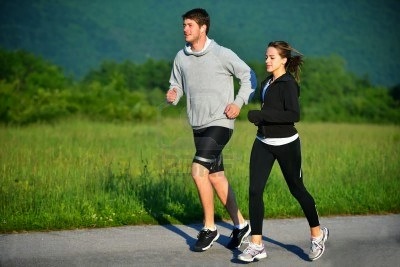 It's Summertime. People like to get outdoors early to run, bike, or swim in the sea for an hour or so. It feels great, but, other than wholesome recreation and mental health, what is it good for? I will try to discuss these things.
It's Summertime. People like to get outdoors early to run, bike, or swim in the sea for an hour or so. It feels great, but, other than wholesome recreation and mental health, what is it good for? I will try to discuss these things.
Our posts about what I term Phys Ed are meant to be about general conditioning for relatively-healthy people of any age rather than training for specific activities. That's why we recommend 1/3 weights, 1/3 "Cardio," and 1/3 calisthenics. With that said, I'll review some general ideas and misconceptions (expecting arguments from readers). People use the term "Cardio" for many things, but we intend it to mean training of the heart muscle.
1. "Long Slow" exercise, often termed Cardio, is not Cardiac Training. Swimming a mile, jogging 3-5 miles, biking for a few hours, doing 45 minutes on the elliptical or treadmill doing Long Slow do not elevate your heart rate enough to challenge your heart. Ideally, you want to stress your heart because that is what Cardio is meant for. Intensity is more important than time from the heart's standpoint, same as with weight training.
That doesn't mean that those activities are a useless component of general fitness, just that they do not build cardiac strength. If you can run or jog 3-5 miles, you might not be fully fit but you are better than most slobs.
To strengthen your heart and increase your Cardiac Output, you have to push your heart muscle in the same way that you push other muscles with weights and resistance. That means basically heart rate stress. If you can work your way up to maintaining 80% of your max heart rate for 30 or 40 minutes, I'd say that is very good indeed. How to determine that is at the end of this somewhat lengthy post -
Still, we feel it's a better idea and more efficient to do HIIT cardio training which pushes your heart to as close to 100% for brief periods - 30-60 seconds followed by a slow recovery of 3X the sprints. 20-30 minutes of that once or twice a week is good. This can be on the road, elliptical, rower, in the pool, or on the treadmill or stair machine. Max effort, max sweat.
More below the fold -
2. "Fat-burning." Exercise is no way to burn fat you want to get rid of. It takes 40 minutes of uncomfortable effort for your body to even begin to use fat as an energy source. Fat loss is 95% nutritional. Exercise can help with that by making us more aware of how our body might be holding us back thus providing motivation. Also, all exercise reduces appetite. Sedentary people have higher appetites in general. Our rule of thumb: When you feel hunger, it tells you that you are burning fat so if your are fat, welcome that feeling, and if you are too skinny, Eat Something! A Big Mac with fries. Anything!
3. Road running and jogging. However pleasant it may be, we do not recommend too much of it. It is hell on your joints and, in time, you will pay the price. On a cool morning, go out there and do 20-30 minutes of HIIT sprints and you will get much more cardiac bang for your buck. If addicted, try to limit to one long run/week.
4. Long Slow for maintaining functionality: Sure. That's great, much better than sedentary. It does not buildfunctionality or energy though once you do your daily hour. Furthermore, repetition of the same "cardio" exercise reduces its usefulness. What about walking? Everybody tells you to, at least, go for a walk. Walks feel great, but don't do much for fitness except in the elderly. Walks and hikes are recreational, not exercise. If a 3-hour walk counts as exercise, a person is in terrible physical condition.
5. Soul Cycle and other Cycle classes, and Cardio/Calisthenics classes: Cycling classes tend to push the cardio intervals, so that's good real cardio with zero impact on joints. In Calis classes and calis in general you keep your heart rate at the 60-70% perhaps for an hour, so it's not cardiac stressful but it's cardiac-maintaining. Calis are for general fitness, endurance, toning, and athleticism. Good stuff but not cardiac training per se.
6. Endurance. It depends what you mean by that word. Do you mean 8 hours of ditch-digging, running a half-marathon, carrying lumber all day, playing 4 sets of singles tennis, completing a tough one-hour exercise class, or keeping up with the leader on a 12-mile hike? Endurance is specific to the task. All I can say about it is that our 5 1/2-7 hr/week program will certainly improve your endurance for all recreational activities.
Summary: For general fitness and conditioning, set your program up so you can fit in maybe two half-hours of HIIT and maybe an hour of endurance long slow along with your calis and weights. That's a balanced fitness program. A 4-5 hour hilly hike certainly substitutes for a long-slow session.
Heart Rate:
For cardiac training, your heart rate has to be 80% of your age adjusted max. Your age adjusted max is 220 minus your age for men, 208 minus 82% of your age for women. The easy way is 220 minus your age, take away 20%. To be in the optimal cardio range, your heart rate has to be at least 80% of your age adjusted cardio max. Even better if it is at 100%. You are really buff if you get it to 110%. Don’t try that at home.


 It's Summertime. People like to get outdoors early to run, bike, or swim in the sea for an hour or so. It feels great, but, other than wholesome recreation and mental health, what is it good for? I will try to discuss these things.
It's Summertime. People like to get outdoors early to run, bike, or swim in the sea for an hour or so. It feels great, but, other than wholesome recreation and mental health, what is it good for? I will try to discuss these things.